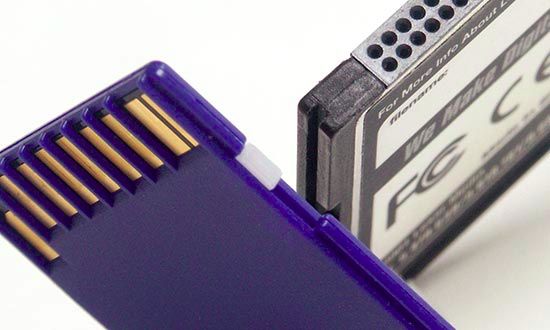Pixels are NOT free
24/06/08 12:04 Filed in: Business

Memory cards. Photography by Mark Lyndersay.
Now that I'm looking for the damned quote, I can't find it at all. But it's in there, I know it, it's just crammed in with some of the best location shooting advice ever gathered between two covers of a book and I keep getting distracted.
The book is Joe McNally's excellent and highly recommended "The Moment it Clicks," a collection of photographs and behind the scenes stories and technical advice from a shooter whose style is essentially "bring back the best shot."
Somewhere in those pages McNally wrote the words, "pixels are free" and it jumped out at me. Not so much that I'd drop a Post It on the page so that I could find it again, and I'm sure that it was in the context of shooting in the same situation with film and trying to set everything up again.
McNally, who has an imposing collection of gear, knows damned well that pixels aren't really free, but some new photographers and practically every client on Earth is convinced that they are, so here are some thoughts about that popular fallacy.
A new 4GB memory card sells now for less than US$60, just about what it cost to buy and process a few rolls of 36 exposure film, but you can wipe that card and use it until it fails, which for a well-made card is quite a few writes and rewrites.
So after you've shot the equivalent number of film frames, the card is free, right?
Well, no.
Every image has a cost before and after it's made.
The card has to be put into something to make an exposure, and unlike the good old days of the Nikon F3, the digital camera you buy today has a radically shorter shelf life. Even if the physical equipment holds up, the reality is that advances in sensor chips practically ensure that a camera has a useful life for a professional photographer of around three years.
Any pro worth his salt has built his business around the reality that the cost of a digital camera should be absorbed by billings within a year, eighteen months tops.
If you don't have the billings to cover the cost of the camera you want in that time frame, then it's time to either set your sights lower or start hitting the streets for some more work.
After you capture the image, it's time to start preparing the files. High resolution image files demand a fair bit of processor horsepower if you want to finish your work in something approaching real time, so that's either a state of the art laptop, if you're hooked on mobility, or a serious desktop, both kitted out with giant gobs of RAM.
Your digital darkroom has a useful life that closely tracks your camera equipment and needs to be amortized on pretty much the same schedule, so that's some more fixed costs to add to your annual bottom line over the next year or two.
Add in your costs for editing and organising digital images while you're working with them and your costs for these "free" pixels just keeps rising. I estimate that for every hour I spend shooting, I need to match it with at least another hour in Lightroom making sense of the shoot and prepping it for client review and approval. Then there's finalising work in Photoshop, which can escalate into insane amounts of fussing time when I'm feeling particularly anal retentive.
Then there's the dark abyss of digital photography, storage. Having shot, edit, post processed and delivered your best work, you need to keep it.
This is one area that film has digital completely beat. I have shelves full of binders with negatives of my work over the last 30 years that are still accessible, but there are images I've shot just six or seven years ago in digital format that are gone forever.
An archival and retrieval system for photographers is pretty easy to put together, but it's an enormous pain in the butt and easy to forget to put in practice.
The reality is that both hard drives and optical media fail, so you can't trust either. Old media must be regularly migrated to new media, unless you plan to keep an old system around that can read SCSI drives, and even the best optical media should be rotated out in favour of newer discs.
There's a method to the madness that I work with, and I'll probably do a post about that later on, but more germane to the matter at hand is that it costs money just to keep pixels active and available.
If you aren't bothered by any of this, then you should cost your photography according to the ease of use afforded by modern digital photography methods, but any remedial efforts you make to salvage the work afterward will be coming out of your pocket.
I like to at least work at the pretence that I'm running a business, and that means factoring in the real as well as the anticipated costs of capturing, editing and maintaining a professional photographic archive of work. And my pixels end up being pretty damned expensive.
blog comments powered by Disqus